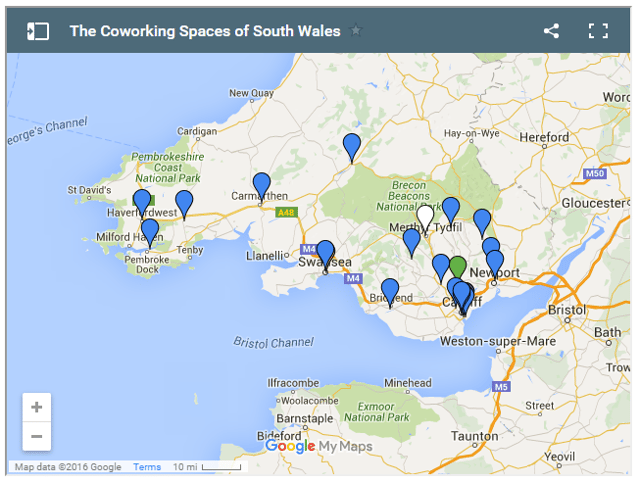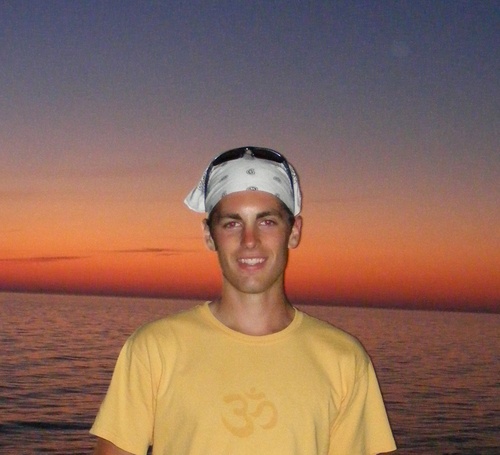Welcome to the third annual post in our Link Building Success Stories series! You can see the shared stories from 2014 and 2013.
Each year we ask SEOs across the industry to submit a story highlighting a campaign, tactic, or even individual link that led to a success worth sharing. The goal is simple: to compile an anthology of individual stories that reflect the creative, hard work involved in SEO and link building.
Individually, these stories demonstrate the various tactics working in online marketing. When viewed as a whole, the goal is to portray the state of the industry (and the wonderful people who make up our community).
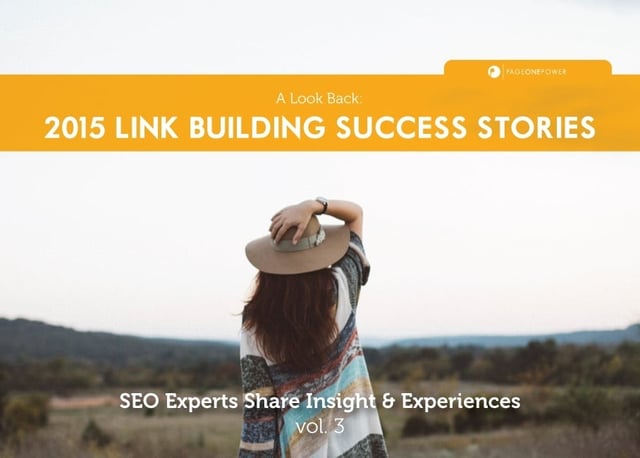
Here at Page One Power—and Linkarati specifically—we want to foster a community of SEOs who share experiences, insight, and even simple comraderie.
I hope you enjoy this roundup, the stories offered, and learn something new.
Thank you to all who have ever interacted, contributed, left a comment, or even simply read Linkarati's content. I'm so grateful for each and every one of you.
And of course special thanks to all the wonderful people who contributed a story featured here. Thank you for being generous with your time and experience. The SEO community is a wonderful, caring group, and we were once again floored by the response from the community. Thank you for sharing your stories.
This year, I've decided to organize by story type/focus rather than by individual contributor. There were a few common themes throughout, although of course each story was unique in some way.
The categories are:
- Content Promotion.
- Relationships.
- Publicity and Mentions.
- Innovation & Creative.
- Business-oriented links.
Content Creation and Promotion For Link (and Marketing!) Success
My favorite campaign from 2015 was when we tried to push ourselves beyond our comfort zone.
At NeoMam we have been sticking to the static infographic for a long time mainly because it works so well.
But in the second half of 2015, we moved into video and saw some great results. So with this campaign we did for BuddyLoans we decided to try something new with the video format.
We followed our usual ideas process and came up with the idea:
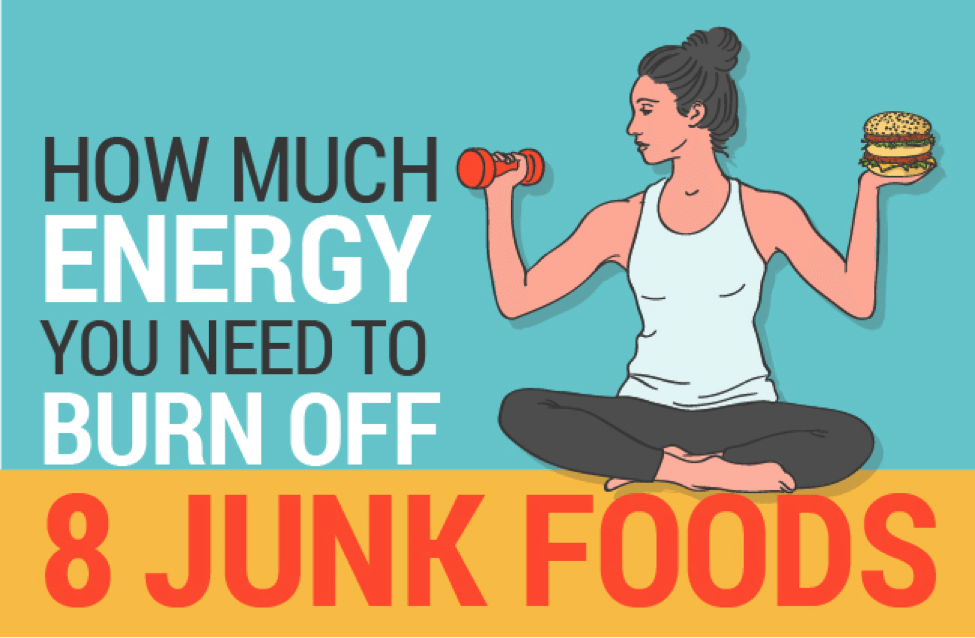
The plan was an infographic plus video but with this project we decided to use live video in combination with the animation style we had done many times before.
With that in mind we got in touch with personal trainer and swimming coach Alistair Mills and asked whether he would be our expert and model for the video.
The end result looked great:
And thankfully the results matched the extra time we invested to make this project extra special:
- Number of editorial features: 80+
- Estimated coverage views: 2.39M+
- Social media shares: 20.6K+

If you're interested in learning more about this campaign we wrote a blog post about it: http://neomam.com/blog/neomam-hall-of-fame-how-much-energy-you-need-to-burn-off-8-junk-foods/
Right at the beginning of the year, I ran a big 'content blitz' campaign on behalf of my parents' IT recruitment agency - they were celebrating their 25th anniversary so we published 25 posts in one month to mark the occasion. I had high hopes for a lot of the content, as we put a lot of work and thought into what to publish, and although some of it didn't garner as many links as I'd hoped, there were a few interesting examples that led to additional linking opportunities and also performed well outside of SEO (e.g. via social media):
1) The Coworking Spaces of South Wales (link) - Coworking is becoming a popular trend at the moment, and we realised that no one had created a resource showing the locations of all the spaces locally - so we made our own. In addition to listing them all alphabetically with info and photos, we created a custom Google Map with colour-coded markers corresponding with each space's branding. Even though we ran this content campaign in January 2015, we are continually updating it on an on-going basis.
In addition to being shared a lot on social media (especially Twitter), which we tweet every time we update it (letting the coworking spaces know that they've been added - often resulting in them RTing it), we were asked to guest blog about it from Cardiff's main entrepreneurship community's website. Said community is very strict on self-promotion in their dedicated Facebook group, but a few of its members have shared it a few times - and they've even encouraged me to share it myself! It's also been added to a coworking wiki. It's genuinely been considered a handy resource by many people, and considered a go-to resource for some folks - some of whom might be potential clients or candidates for the business.
2) What Do 16 South Wales IT Employers Look For in an Employee? (link) - I know, I know... It's an expert roundup (a.k.a. 'crowdsourced content'), but bear with me here...! :-P Some people in the SEO/content marketing industry have gone a little overboard with roundups (this website notwithstanding!), but outside of our industry I've barely seen it used at all. Also, whereas SEOs would ask other SEOs for their opinion, what's stopping people from asking past/current clients and even potential future clients? So in our case, instead of asking other recruiters (i.e. potential competitors) to contribute, we asked IT employers (i.e. potential clients) instead. The result was great:
- Many of them tweeted it, either in their own right or they RTed it when we let them know that they'd been added
- A few of them shared it from their sites/blogs
- One contributor actually came on-board as a client ("thanks for asking me to contribute... oh by the way, I actually need help recruiting someone...")
We tried the other way around as well (What Do South Wales IT Employees Look For in an Employer?) but we had fewer responses, probably because people weren't motivated to contribute and maybe even because they were worried about their current employer's reaction if they saw it - but the employer side worked a treat. It's got me thinking about doing more of these, but just being careful not asking dozens or even 100+ people, which might be considered overkill.
As I mentioned with last year’s example we typically try to focus on link building campaigns that will be repeatable and customizable across different industries, so that we can “fail proof” and mitigate risk for content assets. We also try to have assets that have keywords a client (or our own site) would want to rank for, so that the document itself drives organic traffic and the links will tend to be more on-topic.
That’s a tricky combination of boxes to tick off :), but one type of asset we used quite a bit in the past year was “State of X” types of industry reports (with X being a whole industry, or possibly a sub-set of an industry – you’ll want to do some research into who, if anyone, has done this kind of work previously and where the “white space” and most interesting data can be found). Ideally, these would contain some proprietary, anonymized data that you can provide, but even if not you can usually hire a writer/researcher to pull the data from a variety of different sources and come up with something unique and interesting. From there you want to focus on a few areas:
- Pull a list of any reporters who have covered your niche (even if it's things like funding events for companies in your niche, trend stories about publicly traded companies in your area, etc.).
- Distill your report into a few really interesting and intriguing data points that you can use in a pitch email to the journalists who may be interested.
- Create a nice, concise, sharable data visualization that can be easily shared and embedded into posts (your report will have a bunch of visualizations, hopefully, but this would be an additional infographic that you and other bloggers can include as an overview in short posts summarizing the study).
- Line up a few guest post contributions (a la guestographics) to talk about specific aspects of the report in depth. If you have 3 really attention-grabbing bullets that will be interesting to folks in your niche, each of those can probably be teased out into a full post based on the data from your report.
- Make the meat of the report easy to access (possibly as a full HTML page) but have a walled version of your report where you can collect emails. It may just be a simple difference of the PDF version being behind an email gate, or you may want to offer some additional bonuses (e.g. the raw data from your survey if applicable, a video interview with your researcher or someone at your company talking about the findings and methodology, etc.)
Even if you swing and miss at some of the bigger press outlets, by making contributions at relevant blogs you’ll have a few guaranteed links lined up, and with additional outreach, sharing the study with your list and social followers, and potentially doing some strategic paid social advertising for the asset you can get a lot of run out of a single asset while potentially having the same piece of content drive leads, get links, and rank for valuable organic terms in its own right.
We worked with AccuRanker on creating Google Grump: https://www.accuranker.com/grump/
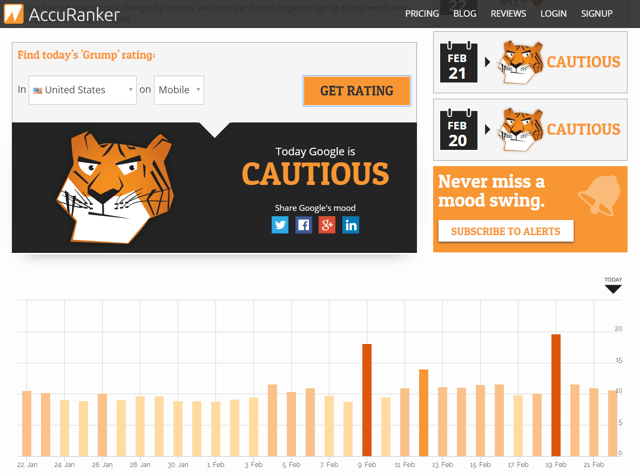
AccuRanker’s Google Grump rating is based on a unique algorithm, built to calculate the average number of rank changes, across the top 100 results per keyword.
AccuRanker’s Google Grump monitors 28,000 randomly selected keywords split 50/50 between mobile and desktop.
When the ranking changes increase the index jumps up and changes the mood. In the screenshot above Google’s mood is cautious, which indicates there is some activity, but nothing indicating a possible Google update.
We’ve then promoted the tool and have daily alerts to build the audience for AccuRanker, but also to gain coverage and links.
At the time of writing there are 46 unique referring domains pointing at the page according to Majestic. Majority of which are natural coverage in the SEO community.
All of these links are relevant and many are high quality, which would usually take a lot of time and effort to acquire.
The thing I'm most proud of/excited about in the past year is how much content we're creating that ties back to a top-of-funnel search term, and still generates links. If we can both build a ton of links and build brand awareness through the top stage of the funnel, we have huge growth potential, as compared to something like a one-off linkbait piece which can only power the bottom-funnel landing pages.
While I can't give client examples, we are starting to do a lot of this for ourselves. Our recent post on the 100 best infographics is already page one for "best infographics" and has the potential to rank for a lot more than that. It generated 30 LRDs with not much organic outreach, and also helped push our infographic design services page, which previously ranked page three, to the top of page two at the time of this writing.
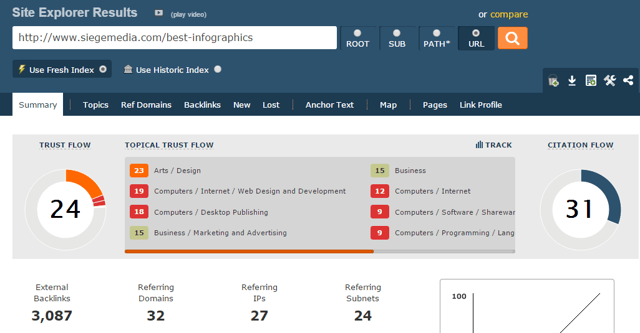
That's the perfect 1-2 punch you hope for when creating top-of-funnel content like this.
The general formula to this type of content, while almost cliche at this point, is create something you feel is significantly better (or close to 10x) than other content currently ranking. If you do that, and also note that the content ranking already had generated a significant number of links themselves, it's pretty much a lock that you can achieve similar success.
I think the most successful (and fun) link building tactic I’ve worked on this past year was for Modernize. Basically we built out several of these large data driven articles, which have multiple accompanying graphics. They’re somewhere in between infographics and articles, but not quite one or the other.
Here’s an example: https://modernize.com/home-ideas/18126/the-sun-on-social
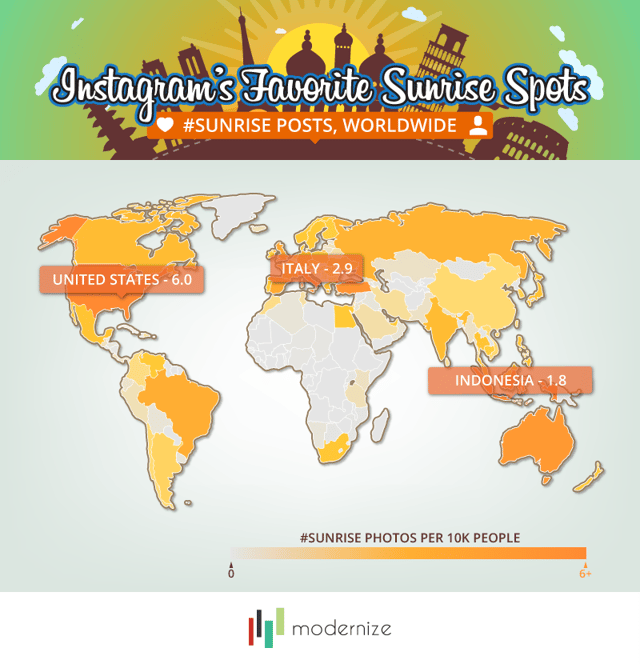
Basically, after we build them out (but before we publish them), we pitch them to top tier sites and offer them exclusivity in announcing them. Their version is not an exact duplicate of our own, but instead uses some of our assets and mentions us as the original source. Once someone agrees to publish it, we then make the post public on our own post.
Not only does this get us a link from large publications, but also several other syndicates that follow these sites to repurpose their posts. This has landed us on several top tier sites with a domain authority of 80+, including Mashable, Metro, and Daily Dot.
The good news is that 2015 has been the year that brands really started to get behind the value of content campaigns as part of any digital strategy. This has allowed Zazzle Media to really flex it’s muscles in this area. After fighting to be able to push the boundaries in this area for several years, it has been both rewarding and exhilarating to see that hard work on education bear fruit.
As a result there have been a plethora of great example campaigns I could share at every possible budget level. We won a SoComm Award earlier in the year for Skyn Condoms thanks to the massive social reach and traffic it received despite the smaller budget we had to play with.
The concept behind the campaign was to jump on a trending topic (The launch of the 50 Shades of Grey movie launch) to ‘sell in’ an interactive quiz designed to tell users how ‘grey’ their sexual habits were. The point of the campaign was around brand awareness and sampling requests (users could qualify for a free product!) but because of the international coverage it received it also had a significant impact of search visibility as a simple secondary effect - proving the value of integrated approach.
We have also seen some amazing results for ao.com using this integrated approach. A piece we have just completed, for instance on Christmas recipes smashed our own target by more than 9000% thanks to a huge amount of major news sites picking it up, including the likes of Daily Mail, Cosmopolitan, Daily Express, News Thump, Yours, Gurgle, Good Housekeeping, and others.
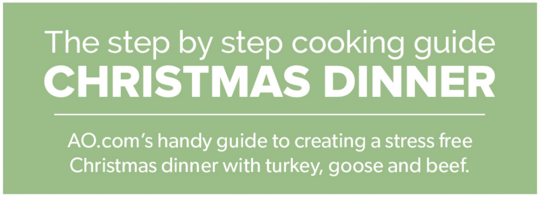
The concept was to create a hub for Christmas cookery hacks and ideas to make the hardest meal of all easier.
The Value of Relationships in SEO, link building, and Online Marketing
Ironically, ever since we launched our SEO tool, we haven’t built a single link. Fortunately for us, other people have been building them for us.
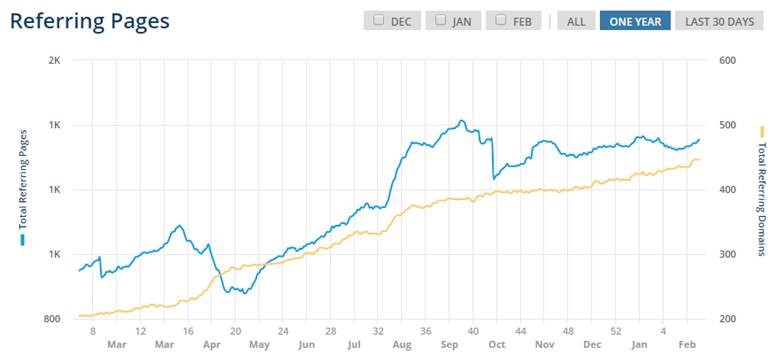
Whilst we haven’t spent a great deal of time actively ‘engaging influencers’, whenever a high profile name in the industry took an interest in our tool, we offered them as much help as we could and often gave them free licenses.
Mike King was one of the first people we gave a license to, and he has since mentioned us in dozens of conference talks and blog posts. Some of his ideas even take our product to new levels.
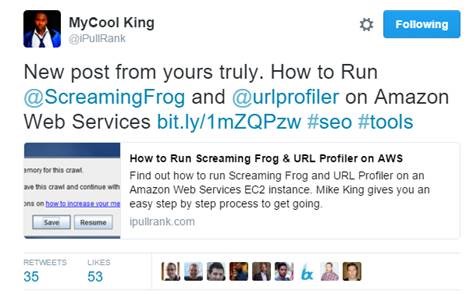
Aleyda Solis is somewhat of a tool aficionado (she does run The Marketer Toolbox, after all), and she showed a lot of interest when we reached out to her. Having Aleyda as a fan of URL Profiler has been a big win for us, as she does presentations all over the world, and blogs constantly.
Since she often blogs about tools and how to use them, she regularly mentions our product :)

We supported Matthew Barby when his excellent blog was just gaining traction. 18 months later he’s working for Hubspot. Guess who he links to in his first blog post.

I also reached out to Glenn Gabe to see if he’d be interested in checking out our tool, and gave him a 1-on-1 demo to show him what it could do. He’s since mentioned us numerous times on his own site and various others, including this post on Search Engine Land.
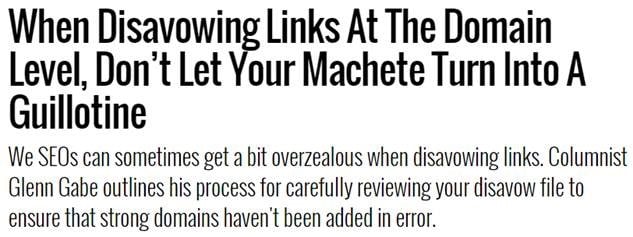
The best thing about these links is that they are just a pleasant consequence of an otherwise worthwhile business relationship. These ‘influencers’ are both our exact target market and highly experienced in the field, which means the feedback they give us is just as valuable as any links.
But having these guys out there flying our flag, dropping links, shares and mentions all over the place, is extremely valuable for our brand and our business. And there’s not a link request email in sight.
At the end of 2015 I started working with a company called RoverPass (think Kayak for places to stay in the RV industry). They were struggling because nobody knew who they were and in the RV industry people hesitate to link to anyone they don’t know.
So I came up with a strategy to create a list of the best RV blogs and a badge (pictured below) for the bloggers mentioned so they could show off the badge on their site.

Strategy Goals
- Get noticed and build relationships with bloggers in the industry. Check!
- Build authority - who can pass up getting links? Check!
Results
- Post now ranks on the first page of Google for several keywords like “rv blogs” (1,300 monthly searches).
- 12 Badges placed so far, most are site wide which helps RoverPass’s backlink profile.
- 500+ blog post shares.
- 45 comments - mostly people wanting to be added to the post :)
- Greatly increased our referral traffic from industry blogs because people are clicking on the badge.
Out of sheer good fortune, we picked up links in the past year by giving product feedback and testimonials to companies whose tools or software we use.
For example we made suggestions to Pitchbox on improving the platform, not only did they implement them they codenamed the product update after our company - The 'Kaizen' update - complete with a linkback.
Go reach out to your partners and if they have a case study or testimonial page be pro-active and ask if you can be listed with a link back. Everybody wins.
Monitoring websites that are actively looking to engage industry experts for upcoming publications helped us build many links in 2015.
We monitor websites like HARO and MyBlogU on a daily basis to find writers looking for experts to contribute content. This strategy has helped us build great single links for our clients AND helped us grow our network of publishers in a wide range of industries, which we now leverage for future link building opportunities.
Through promptly responding to requests and providing great information provided by our client, we were able to build many great links, including a local restaurant featured in Men’s Journal or a local divorce lawyer featured as an expert source by The Huffington Post.
In addition to building great links, these articles typically receive social engagement, drive referral traffic, and are great for our client's overall brand.
OK, so you need a link building success story from 2015. To be honest I really had to think hard to find one. I didn't have any flashy link building successes like the ones you see on SEO blogs these days with headlines saying something like "How I got 100K Editorial Links in 7 Days". I have been doing a lot of sometimes tedious hands-on outreach work in 2015.
In fact at the end of the year I stopped writing for SEO blogs altogether because there was so much outreach work. The demand for outreach has been growing steadily it seems. That's because content may be king, but the Web is not controlled by a monarchy like Saudi Arabia. Link is president in the merit-based democracy online.
As you might know influencer and blogger outreach is hard, especially outside the tiny SEO niche itself where everybody knows by now that's it's a give and take. Reaching out to bloggers is difficult. Many of them do not even respond.
Yeah, I know what you think: "they do respond when there is value for them". I know that too. To me fixing a broken link on your site, offering stellar content you can use for free and the like are valuable, but most bloggers do not even care it seems. They'd rather let their content rot even when you offer a better working alternative for a dead link.
As long as you are trying to reach out to strangers and doing cold outreach you are in for some disappointment.
People do not even reply most of the time. Some want money to link to you or even use your content. Others simply ignore you. That's when I tried to combine my tried strategy of relationship building with client demand for quick and dirty outreach. Instead of finding strangers who have shown interest in similar content in the past, or have a broken link I can fix, I started to look up my connections from past relationships with online friends. I checked whether they covered a similar topic as well.
Some of my "relatives" from the blogging, social media, web dev, and marketing spheres haven't been in touch with me for years.
Yet, while the strangers wouldn't even respond, the people who knew me from years back did. Thus when trying to get links from strangers I would connect with roughly 25 people to get two links. After using established relationships I contacted like three online friends to get the two links. At first I thought it was just coincidence but it worked like that for more than one campaign. It's amazing how a bond forged years ago opens doors years later.
Thus all that "relationship building is the new link building" talk is not just about unicorns. It also results in editorial links on valuable sites.
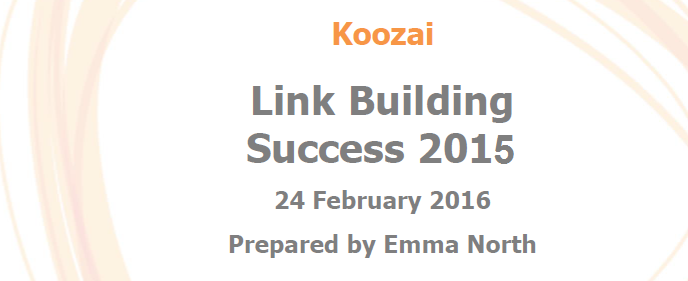
Relationships and Content Marketing
Relationship building plays a key role for us when it comes to link building for our clients. Some of the strongest links and citations we secured last year, from sites including itv.com, thedivorcemagazine.co.uk, and a wealth of local and national news sites, came as a result of having strong relationships with editors, authors, and bloggers.
We’ve secured some great links, citations, and social shares from high profile sites, brands, and influencers in a number of industries through personalised, targeted outreach, and relationships. But not just strong links that provide “link juice”; links that deliver valuable referral visitors who then further engage with the brand or go on to convert.
One of the main ways we secure valuable links is through quality content marketing, ranging from guest content to high-end interactive content. Like most reputable agencies in modern SEO, we don’t waste time with low quality link building techniques, or anything that could be considered black or grey hat. With the results we’ve seen from our content marketing and outreach over the last two years, leaving old tactics in the past where they belong is a real no-brainer.
Measurable Goals
Another big shift we’ve seen over the last two years is the importance of goals and attribution when it comes to content and links.
Every piece of content, every outreach email, even every tweet we put out needs to have a specific goal that we can then measure. Otherwise, how can we call a top-quality piece of content a success? Are we looking for links, social shares, referral traffic, engagement, or conversions? Everything we do is closely tied to measureable goals that fit with the client’s needs and expectations.
We’ve stopped focusing on “link building” and started focusing on delivering the right results for our clients and our own site too.
We’ve made a conscious shift on our own blog from posting daily, to posting twice a week, to now posting when we have something of real value to deliver. That might mean we don’t post a new blog post this week, or it might mean we post two or three. But what we do know with much greater confidence is that when we do put up a new post, we will promote it to the right audiences and it will draw more eyeballs than a regular, twice-weekly post is likely to.
For me, link building in 2016 is about a continued shift in mentality that started maybe two or three years ago. It might sound tired, but it’s the truth; focus on quality content, measurable goals, and overall project strategy.
I don’t have a team of link builders or automated emailers and I’m not pumping out hundreds of links per month.
When PositionDIGITAL scores great links for clients, it’s because I personally make them happen via research, outreach, and creativity. This is why, for me, link building in 2015 (and going forward) was all about transparency and increasing and leveraging my online authority. One of the best examples of this was the strong relationship that I formed with an authoritative, educational .org site.
After identifying them as a must-have relationship for my client, I reached out and offered to use my personal online authority (i.e. big sites I already write for), in order to give them some online exposure. I’ll say that again… I simply offered them “free” exposure on another big website that I write for.
In return for helping them get this great exposure, they allowed me to publish some content to their awesome site, resulting in a sweet client link. But it didn’t stop there.
They were so happy with what I did for them, that they ALSO created a special comparison page on their site that nicely highlighted my client’s products and services AND gave me a glowing personal review on LinkedIn. They were thrilled. I was thrilled. Most importantly, my client was thrilled. And it all happened as a result of being upfront, honest and following through on what I promised. Too me, this is what it’s all about.
And this isn't the only amazing exposure I received for clients using this technique.
This is why, in 2016, I’m referring to what I do as Digital PR instead of “just” Link Building. Even though a link is one of the results, it's not the END result. The other benefits of Digital PR include: relevant traffic, social shares, increased brand awareness, and perhaps most important, the opportunity for my clients to build REAL relationships with big industry websites in their niches. These types of connections are invaluable when trying to build authority.
As I increase my digital PR arsenal in 2016 writing for such sites as HuffPost, Business.com, and Examiner, I’ve therefore got my eye on many other authority sites like Inc.com, Entrepreneur.com, and maybe even Forbes.com someday soon.
The greatest success I have had with link acquisition surrounds outreach and establishing real and meaningful connections.
In an effort to acquire links to my triathlon coaching and training website, Better Triathlete, I conducted much of my outreach by using Google to search queries like "triathlon inurl:blog" or "triathlon inurl:links". This enabled me to pinpoint related sites that had a blog or links page - two primary sources of acquiring new backlinks.
After drilling down in the search results, reaching out to webmasters and site owners, and establishing connections, I have formed lasting guest blogging relationships as well as acquired several new static links from topically-relevant sources. In addition to acquiring new and valuable links to my site, I have also cultivated real relationships with influencers in the sport. This has helped to magnify Better Triathlete's social outreach, as well as provide a number of different blogs and online publishing sites willing to host my content.
It should be an exciting 2016, to say the least.
When we were performing link prospecting for our client in real estate niche, we decided that one of the leading online financial magazines would be a great place to secure a link for our client. For around two months we were trying to reach the editors via contact form, direct messages, and social media without any success. They were not accepting external contributors, and what is more, their external linking policy was very strict.
When we were close to giving up, our team member found out by pure chance that one of the platform’s editor is his high school deskmate! He reached him through Facebook and just a week later, we secured a really nice editorial link to our client’s website.
In my opinion that situation proves how powerful relationships can be in terms of leveraging them for link building purposes. Sometimes people are not aware of some of the link opportunities they have just around the corner.
Link Opportunity in Publicity and Online Mentions
Due to the signal/noise ratio in the SEO space, I tend to keep my contributions to private groups these days. If I notice something new in SERPs or strategies that scale, I'm inclined to share it with the private groups I'm in first and wait for someone else to break the news/changes to the public.
I'll check keywords in verticals G has moved into relatively frequently to keep an eye on what they're doing. In late November, I noticed a new auto loan calculator showing for a few keywords, ran it by some friends—who'd also never seen it—so, I decided to tweet it out to the major SEO news breakers. Ended up getting a linked mention on Search Engine Land alongside Dr. Pete. Sweet.
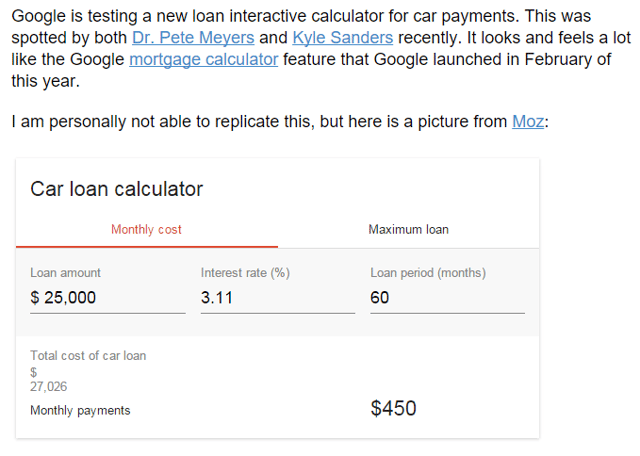
If you work for a brand that generates organic mentions, looking for unlinked brand mentions can be a quick way to gain some great backlinks.
At my current role at Optimizely, I have the fortune of working for the market leader in the A/B testing space, and our company regularly gets mentioned in news articles and blogs talking about the technology. However, bloggers don't always link to our website when they mention us in their articles, so link building is often as simple as reaching out to the writer via e-mail and politely asking for a link to us. Last year we were able to obtain several high authority links this way, and it only took minutes to send the e-mails.
The two services that I use to look for unlinked mentions are Google Alerts and Mention. Both are free services that search the web daily for keywords that you specify (in our case, our brand name) and send you an e-mail when they find new mentions of your keyword. Through these services I get a daily digest of all the sites that have mentioned our brand name, and I go through them weekly to identify linking opportunities.
Some blogs and websites have policies against external links, but it never hurts to ask. Even if they decide not to link to you, reaching out to bloggers can get a conversation started which can lead to other opportunities such as guest blogging and co-promotion, which has happened to us on a number of occasions.
Over Christmas 2015, we had a lot of positive experiences with press outreach and trying to get some of our clients’ products and services in front of journalists.
Christmas time is perfect for outreach for them, so we used journalist services such as HARO, Gorkana, and Response Source to receive enquiries from people all over the world looking for Christmas guides. Usually, the journalists were looking for ideas for colourful gifts, or gifts for 'the man who has everything' etc., so we'd send back a response with high resolution images, a bit of content about the products, the company itself, and we've had brilliant success with responses.
Over Christmas, we achieved coverage from companies such as Sky Scanner, The Daily Mail, The Guardian, We Buy any Car, etc.
Now, this doesn't work with every single client you bring on board, because some products are very hard to achieve links for. That being said, earlier in the year, we achieved links via press services for companies who sell gardening equipment, luxury jewelery, and greetings cards - it's really just a case of looking at your clients and seeing what their seasonal trends are.
For relatively little cost, you can gain some really valuable links which not only improve the backlink profile of the site, but also bring in referral traffic to generate natural sales!
One of the most challenging industries I’ve done link building for is industrial manufacturing.
Ironically, in 2015 I had 4 industrial manufacturing clients. After struggling to find link opportunities in the same way I had for other clients, I had to take a different approach.
My first attempt was to find industrial magazines that fit each client’s niche and build partnerships that would hopefully result in links via content submission. This was working, but progress was very slow given the amount of input needed from each client. Industrial manufacturing tends to be very technical, so my client’s expertise was always needed to create valuable content. Since this approach required a lot of time and resources, which used up a large portion of the client’s budget, I had to find something else.
Someone on our team suggested HARO, which I had heard of before, but never used. We registered our clients and started monitoring requests that were relevant to each client’s industry. This has been a great success and has saved us time in prospecting. If we get a request from HARO that fits our client, we send to them and they submit their pitch. In order to take this approach to the next level, we began utilizing tools like BuzzStream and Mention to monitor for additional opportunities.
As much as I’ve been a firm believer in the manual approach to building links, these tools have helped tremendously in finding relevant resources that would have taken me many hours to find, if I found them at all. Link building may be more challenging than in the past, but there are tools available to increase efficiency while uncovering quality opportunities to help meet that challenge with success.
One of my clients has a very prominent CEO, the type that is regularly featured on television and mentioned in articles around the web. Turning these name mentions into links was a goal but it can be a challenge to get some websites to link to a commercial site.
Northside SEO advised the client to create an "Official Biography" for the CEO on their site. The goal of this page was to be informational and not overly commercial, and therefore linkworthy.
Once the official biography was published link building became easy. I would simply refine the search window to the past week, export the Google Search results for his name and upload them into BuzzStream. Outreach messages were generic and mostly non-personalized but the links consistently came in because our pitch made sense. In essence it was, "Please link this name to this official bio."
Using this technique we secured over 60 new LRDs to this new page with minimal time and investment and the client saw organic traffic and rankings significantly increase.
After realizing that Business2Community somehow had risen to a DA of 82 and seemed to still be doing sweet juicy do-follows I decided I had to get me some of that.
Unfortunately I couldn't really link them up very cleanly at first and had to settle for no follow bio links, which sucks because the bio's the same for all the posts. After re-reading their submission guidelines I found their syndication clause, which demands a link to the original source at the end, and decided to get clever.
I grabbed a post from the client blog (which I was also maintaining, they've since stopped their content stuff due to a lack of funds) and submitted it for syndication. What I got was a do-follow 82 DA link on a post that then got over 900 shares, mostly via Twitter.
The Power of Innovation and a Creative Approach
I was working on a link building campaign for a local business in Austin, TX. I found a great site that was relevant both topically and locally, and it just so happened they had an article that briefly mentioned our client.
I reached out to the site, thanking them for mentioning our client and asked if they would be willing to link to us. And I heard nothing… I was not surprised by the lack of response. After all, it was a brief mention. Just for posterity, I followed up with them trying to confirm that they had received my email. And again, I heard nothing.
At this point we were moving on with our project, so I decided to call it a day and try to find some better opportunities elsewhere. A couple days later, out of the blue, I get an email from the site:
“I'm not sure why we would do this without incentive. Motivate me.”
Often during our campaigns we receive requests for compensation in exchange for link placement or article publication. However, that falls outside of our best practices so we often have to pass on these opportunities. But it was the end of the day and I was feeling bold so I sent him this:
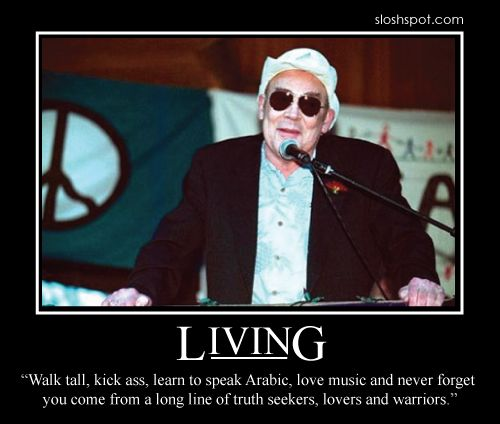
“That's the best I can do.”
I got the link.
Last year I talked about a piece of content that we made that had virtually zip all promotion that went on to do quite well. We have had a few successes this year but none that had the straight up luck that that one did.
So I sat around and had a think about what my contribution would be this year. Would it be one of those off the wall pieces we did that we fought the client to get made and then went on to be viewed by a couple of million people (estimated ;))? Would it be the continued coverage we have been getting in the national press in the last year (blows the trumpet that is widely considered to be owned by me)? Nah.
Some of the most pleasing things for me in the last year has been celebrating firsts:
- The first time that a new colleague gets coverage and a link on a big site (and it is followed).
- The first link that we get for a brand new client that just happens to be on The Huffington Post (and not one of those crappy community posts).
Because the firsts are what set you off. They are the ones that gives you that hit. They start that chain of events that lead you to make cooler stuff, more engaging stuff, more exciting stuff, more detailed stuff, to improve your targeting and your outreach and much more. They drive a lot in this business.
We may get lost in the bigger things sometimes, but we all remember the first.
**And just to balance it out, I remember the excitement last year when we appeared on the planet's highest viewed breakfast show with something we had made. That was a buzz. Alas. Didn’t get a link. Also the mention was sooooo temporal. Humph. I suppose there is always the prestige…
Using Company Social Media Assets to Build GREAT Links
One strategy which has been working quite well is when we use company social media assets to assist with acquiring links.
We find out which social media channels the client is willing/allowed to use and then we reach out to target links using the following email:
"Hello I was searching on Google today and I found [the following landing page].
I was wondering if you would be willing to add X link to this page as it's relevant and I am sure it will provide value for your audience. I also noticed you were linking to X which is similar to our business."
This would involve a high value prospect link or competition based link.
At this point you have two options - the Webmaster will see this and think I am not going to "bother" updating the site, why do I need to? Or you can be more creative!
Add the following line on the email and test the success rate:
"We would be happy to add a post on our Twitter and Facebook pages which have a combined user base of over 20,000 to promote your website/event if you update the landing page X."
This way you are offering a concrete reason for the website owner to update the site. It's like saying "scratch my back and I'll scratch your back".
This strategy is probably not going to work for smaller companies with lower social following or larger brands with very strict social media policies, although it's 100% worth asking and trying. For mid-sized businesses it can work very well and be a great incentive for site owners to get links live.
In 2015 we made several high value placements with this strategy, so it's 100% worth testing.
Every market presents unique local link building opportunities.
One recent example we can share is about an Orlando client who looked to us to help them establish more connections with community members.
We uncovered scads of local Disney themed blogs and we began putting our minds together on what we could do to bridge the gap between a criminal defense law firm and Walt Disney. So we organized a writing contest for local high school students, asking them to answer the question:
"How has Disney been a positive influence in your life?"
In other words, how has Disney helped keep you out of trouble - theft, drugs and other criminal juvenile behavior.
We got the contest in front of local high schools and before we knew it, short essays started coming in and we eventually selected a winner. The winner came in for a meet and greet where she accepted two complimentary tickets to Disney World and granted permission to have her short essay published on the announcement page. Shortly after, we launched our outreach initiative to roughly 750 Disney bloggers, many of which were local.
We ran a 34% URL click rate on the email blast and got a ton of positive responses, shares, and some nice backlinks from local IPs. It was a home run and a great experience for the client and us to be part of.
Marrying Business Development With Link Acquisition
My biggest wins last year were focused more on my entrepreneurship success and online branding for SharpRocket. Things that we’re proud of as a company include:
- Growing the team from 2 to 12 members within 5 months of operations – training new hires was coupled with useful resources/processes that were less time-consuming on our end.
- Getting featured on top inbound marketing community sites like Inbound.org Ask Me Anything, which boosts our branding and helps us acquire new sets of clients.
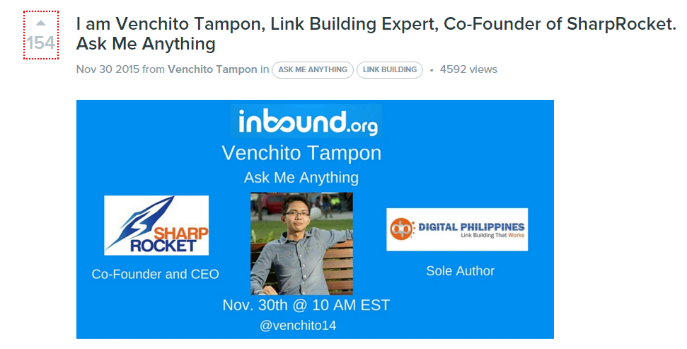
- Helping clients increase their websites’ organic traffic within months of building links to their webpages. Here’s a screenshot of the organic traffic data of a client in the career development niche.
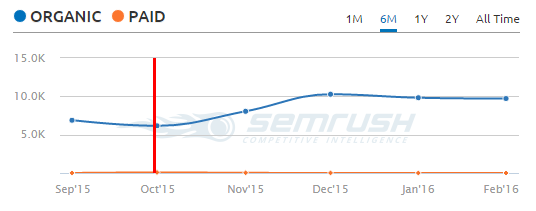
How did we get there?
- We created content assets that serve as extensive guides for specific topics. This targeted content potentially earned editorial links from relevant blogs that helps us build a community of readers in the search industry.
- We invested in ethical link building practices for our clients that aren’t just focused on helping them increase monthly links, but on absorbing clicks, readers and potential customers from webpages through editorial link placement and relevant targeting of blogs/sites.
- We participated in different content distribution platforms, such as answering questions on roundups and/or commenting strategically on other blogs – as we repeatedly do this, our target audience becomes aware of our expertise and eventually become part of our brand community.
2015 was a year of shake-ups and refocusing.
With content creation always being the core of all online marketing and branding, it was important for me to take my personal brand and business to a whole new level. That's exactly what I was able to accomplish through the launch of my Rise of the Entrepreneur podcast.
Big deal, it's just another podcast right? Well, not so much...
First of all, podcasting takes a lot of time and effort, it's not something you can sit down and crank out in 20 minutes like a blog post. Another reason why podcasting is so amazing is because it brings your content and relationship with your audience to life. In my case, I already have a few blogs and I personally write content for a few other partner sites as well. Text content is great, but we all know that the majority of people will never read more than 50% of what we write. This simply isn't the case with audio and podcasting.
So how did launching a podcast help with link building and growing my brand? It helped with everything.
For example... just take a look at some of the names I've been able to interview through my show. Gary Vaynerchuk, Timothy Sykes, Neil Patel and more than 80 others...
Now consider the value (and cost) of what it would take to have each of these experts send out a link to your site through social media, or to link it from their site. In most cases, if you interview someone and promote them, they are going to help promote it as well.
Throw in the bonus of SEO and additional search rankings based around each of your guests' names, podcasting just might be the golden goose you were looking for. The good news is even if you aren't already podcasting or if you hate the idea of listening to your voice, there is still a ton of opportunity with guest blog posting as I had recommended last year!
The interesting thing about digital marketing for most companies is how disjointed it can be from the actual business in the real world. Bridging the gap between the digital world and the real world led to a really successful link campaign for my client. They're in a "boring" industry, making steel doors, so they have felt like they're at a disadvantage when it comes to being interesting enough to be link worthy.
After chatting with them for a while, they just casually mentioned they were holding a small event for local contractors on meeting local fire codes. The wheels in my mind immediately started spinning!
First I had them create a blog post for the event, loaded with the PDFs, documents and resources they had planned to use and asked them to add that URL to the flyer they had printed. I also encouraged them to check and see if their guests had blogs, and to casually mention adding a link to the resources on their blog if possible.
Second, I jumped over to Eventbrite & Eventful to create event listings, which ended up propogating out to 4 or 5 additional sites that pick up their syndication feed, along with the followed link in the event description!
Last I looked up Nashville-specific event websites and created profiles to submit their event. There were 4 unique sites just for events in that city.
Phew! Imagine if they'd just gone and run the event, they would have missed out on all of that link building!
Another year proving that the importance of quality link building will never die is in the books.
Last year was a pretty stable year in terms of the algorithmic updates, but we still always get the same types of questions from clients--big and small--regarding the validity of the link building strategies implemented on their campaigns.
One funny story to share from last year relates to a particular client in the mobile app development niche in North America.
At the beginning of the year, they literally had zero organic web presence and weren't in the top 50+ results for a single keyword on Google.ca or Google.com. By the end of the year the majority of their keywords were on first page on Google.ca and 2nd page on Google.com, organic traffic had increased >300% year over year but still some of the management team had the typical SEO questions regarding link building.
It wasn't until we got one single post on a major media publication that one of the owners finally understood the importance of all the link building we'd done in the past 12 months... just kind of funny that even though the rankings and traffic improvement (in one of the most successful campaigns I've ever executed over the past 8 years) skyrocketed, it was the one specific post that they were finally excited about!
Link reclamation was huge for Stryde clients in 2015.
One particular client had gone through a bad redesign and had lost over 70% of their organic traffic. After cleaning up their website's technical issues and correcting all of the internal links that were broken or sending traffic/link equity to the wrong pages, we saw traffic return to pre-development levels.
Phase two was to use Open Site Explorer, Ahrefs, and Majestic to identify all of the external links that were broken or pointing to the wrong pages, and perform outreach to get them updated. In less than 15 hours of outreach, we were able to get over a hundred links fixed and traffic spiked another 30% and continues to climb.
Last August my team and I started work on a locally-based law client that was battling to maintain position in the local pack, way back in the good ol' days when the local packs contained between 5-7 positions. Once the local packs were cut to 3 spots, our client's desire to show up in spot 1,2 or 3 became the one and only goal.
In order to pave the way for the good links and citations we were going to build, we had to simultaneously perform a backlink audit and disavow over half of the client's previous backlink portfolio. The client had paid for links, and as a result, the backlink profile was rather abysmal.
Now, with the spammy backlinks cleared out and half a year of consistent citation and organic link building, the client ranks locally for an additional two terms (bringing the local pack ranking total to 3).
Without first taking care of the toxic backlinks, our current work could have had little to no impact; it's important not to just do great work, but to be cognizant of any past past mistakes that could impact future organic endeavors.
Ruining other people’s link building strategies
In 2015 I accidentally stopped many types of links from having any ranking effect. Sorry guys!
I shouldn’t have explained your effective strategy to all those spammers because I could have known they would start abusing it. Google Penguin picked up their spam and made some of your links worthless too.
How much abuse is too much?
Penguin can use complex patterns to determine if a link can count as some form of “vote of confidence”. Ignorant abusers will often use a lot of exact match money keywords in all of their links and they make other mistakes that create tell-tale signs of spam. A webpage or content block with such a link on it shows that abusers had a lot of control over it, so all such links shouldn’t count as a vote anymore.
The last couple of years have taught me a lot about Penguin by monitoring links and ranking of many sites. Sites that heavily depended on one type of link showed me when those links lost much of their value. Mainly after heavy abuse by others we noticed a drop in their ranking.
Sponsor links
One strategy that probably still works wonders in 2016 is sponsoring some open source project. In a way this is a “paid link”, but because none of the other sponsors have that same link building intent Google often still rewards these links.
During one of my 2015 conference presentations I shared the dofollow sponsor links on Creative Commons (https://creativecommons.org/supporters/). This page had 16 1000-dollar or Remixer sponsors when I shared it (https://web.archive.org/web/20150116033139/http://creativecommons.org/supporters). That grew to over 55 obvious spammers by October (https://web.archive.org/web/20151015182354/http://creativecommons.org/supporters) and now probably has even more spammy links on it. Of course it could still pass some link value, but I wouldn’t want to be associated with all the others in the list so this option is ruined.
In the last months I’ve mainly worked on creating processes, best practices, and bringing SEO culture into my new company. Because of this focus, I can’t really share anything that brilliant in link building, but I have done a few things with my own side projects.
Some of it could be considered a bit greyhat but I’m sharing this tactic because of the value in it, besides the SEO impact.
I run an 8 year old website dedicated to crime novels (www.thrillercafe.it) that’s now the place to go for news and reviews in the crime genre. Across the years I’ve earned a bunch of good editorial links, even from major sites (including one of the channels of the national Italian radio site – Radio3), but from time to time I secure links by acquiring other websites.
I typically run a crawler (Xenu or Screaming Frog) on culture related magazines and look for outbound links going to sites that are no longer updated.
For example I look for a magazine that no longer exists, and subsequently its website is going to be dismissed or parked. Another example would be a publisher taking down the minisite of a book, and so on.
What I do then is offer to buy the site (or maybe wait to see if it’s domain ownership expires), then move its content onto my own site (or at least the relevant content that makes sense), and then redirecting the domain I’ve bought.
In this way I grow my incoming links through the mergers, like companies do in the financial market. I know it doesn’t apply to every niche, and it requires a bit of cash to buy sites, but being patient often leads to nice bargains, and in the end the strength of your site will thank you.
We had a lot of campaigns in 2015 that I would consider incredible success stories, so it's been a little tough to pick one out of the bunch that I think would be worth sharing.
I'm sure there will be plenty of others in this list will have the whole "we created X content, got X links and saw X% increase in sales" thing covered--many of whom will likely have much more interesting stories than me anyways--so I thought it'd be best to share a story that may be a little different from the others on this page. Because it rocks. Oh man, it rocks. It rocks so much because I barely had to lift a finger.
Okay, this happened early summer 2015. Here we go: so we've got this ecommerce site, right? (Duh). And like virtually every ecommerce site it's got manufacturers and competitors to compete with in search results, right? (Duh). I mean, this site is nothing extraordinary by any means (pretty typical ecommerce site in a competitive niche), but throughout the course of link building for this site I'm seeing some real good positive movement for a handful of our largest terms in a relatively short amount of time. I was actually becoming really impressed with myself with the amount of improvement I was seeing. Like... as in "hell yeah, I am the undisputed king of link building" cockiness impressed. (You've been there. Don't lie.).
That's about the time some jerk started spamming their way to the top of a few of our key terms. From what I gather, said jerk was either a competitor of ours or a competitor of our manufacturer. Either way, it was a giant buzzkill for a month or two.
So this dude gets a single page website ranking in the #1 or #2 spot for a few of our highest volume queries, above our website and the majority of our search competition. This single page website was just 1200 words complaining about how much a product our site sells sucks. Meanwhile, while checking the backlinks of our competitors I kept seeing some real nasty links popping up. Like hundreds per day. Most of the anchor texts were completely obscene and profane and I won't go into further details, however one stood out: "You [expletive]'ed with the wrong guy."
It was obvious that these links were related to this new single page site that is now ranking above ours. I felt like a sitting duck, just waiting for similar links to be aimed at our own site. So I doubled down, built even more of the great links which we had already seen incredible improvements from. A few weeks later that single page site disappeared and the competing site fell into oblivion. We were now #2, right behind our manufacturer (who doesn't sell anything on their website). The competing site which was attacked eventually recovered, but has yet to regain their old positions and our site is still at the top. Hell yeah.
So that was cool. I can't really take credit for much of this besides the work that I actually did, but I justify it as a success because without my work I don't believe the site would be ranking where it is now - even though I had zero to do with the storm that decimated the competition.



